Well, that didn’t really pan out as anyone hoped, did it?
After years dealing with fires, floods and the rolling waves of a global pandemic, you might have thought the beer world – all of us, really – were due a lucky break. Yet, it feels like the trials and tribulations of 2019 to 2022 were merely the support act for an unwanted headline act. (Please, please let 2023 be the headliner…)
It’s not like last year's vintage of this article was all sweetness and light. It referenced: “the impact of the war in Ukraine; more devastating floods; staff shortages; ongoing logistical challenges; rising energy prices; inflationary pressures” in the intro, after all. But, while not everyone has been impacted badly, 2023 has proven to be by far the toughest for the beer and hospo world in the 13-plus years we’ve been covering it on The Crafty Pint.
Some of the challenges cited in 2022 only intensified, while the cost of pretty much everything that is required to get a beer from raw materials into your hands continued to go up at the same time as disposable income for most people went down.
There are other significant factors at play too, some of which have been around for years but have been brought into sharper focus: the challenges in gaining market access due to tap contracts; the growing number of crafty homebrands offered by the country’s retail duopoly; changing tastes and the diversification of the drinks market that sees traditional beverages competing with newer market segments.
Put all the above together with the fatigue carried over from the pandemic, not to mention saturation in parts of the beer market, and you could argue it’s a wonder more breweries and venues haven’t gone under or decided to call it quits. That said, expect to see more voluntary administrations, sales, consolidation and closures in the year ahead.
On the plus side, for all the bleak conversations to be had with brewers, reps or venue owners, there are those of an upbeat nature. Having your back against the wall can force you to become innovative, to dig deeper, and many of those who’ve had – or been able to create – options for themselves have done so, beaten back the wolves at the door, and are looking forward with varying degrees of positivity.
And, of course, if there’s one thing that isn’t to blame for the uphill struggle (or, if you prefer, downward spiral) it’s the quality of the beer on offer. For the most part, it’s as good – if not better – than it’s ever been. Case in point: I had an IPA from WA a couple of nights ago I'd say was as near to perfect as you could want a beer to be.
Sure, craft beer rather overdid the crazy – enabled and encouraged by that period when people were trapped at home with excess money they'd happily drop on 440ml flights of fantasy – and that has given doubters an easy stick with which to beat the industry. But, as they prove a tougher sell, the shrinking of that section of the market (notable exceptions notwithstanding) is, we’d argue, for the better. Sure, innovation and experimentation is great, but it doesn’t have to be everything, everywhere all at once. Indeed, much innovation is coming in other areas, not least the development of cheaper-yet-still-kinda-crafty options for those on a budget, no-lo offerings, and new hop, malt, and yeast products too.
So, as we look forward to *crosses fingers* a bumper summer for everyone and another uncertain year ahead, here’s our look back at the major events and trends of the past 12 months in Aussie beer. Our Best Of Beer In 2023 state by state by territory features will follow in the coming days.
1. Administration & Closures
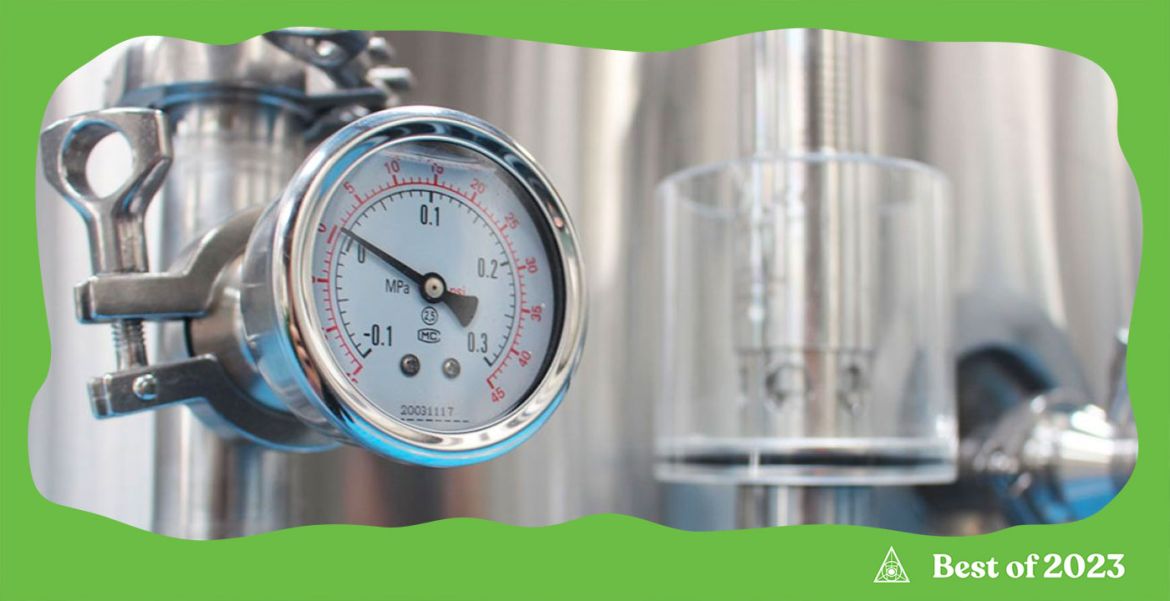
Last year, we called the equivalent article The Best Of Beer 2022, but given the nature of much of what has demanded attention in 2023, that didn’t feel quite right. Hence, this time around, it’s the rather less fanfare-worthy The Year In Beer 2023.
Above all, whether judged by the bare stats compared to every other year in which we’ve published such pieces, or by looking at the articles that typically attracted the most eyeballs in 2023, it was a year dominated by administrations, sales and closures.
We weren’t even out of January before Ballistic Beer Co became the first voluntary administration announcement of the calendar year, and there’s been a steady stream of them since, right through to Dainton last month. The first of them, coming just before February’s excise tax rise, sparked our first long-read of the year: Under Pressure: A Perfect Storm Brewing For Beer.
In the case of some voluntary administrations, owners have restructured their debts (such a polite way of putting it) and managed to retain staff. In others, new owners have come in. Sometimes the new owners have had previous connections with the businesses concerned; in others, like this month's Cheeky Monkey acquisition of Sound Brewing Co, it’s a whole new team at the top.
Elsewhere, the theme of consolidation we wrote about when Wayward and Batch merged last year has reappeared, most notably when Otherside and Nowhereman became one in WA, since when the latter’s brewery has been sold off.
Most people have welcomed the return of their beloved brewery from administration, but such things do come at a cost. While the ATO – which has been coming after the excise tax payments businesses were allowed to push back during the time of lockdowns – has often been among the biggest losers, there are suppliers, big and small, and other creditors who have been weathering losses too. And that can and will have a knock-on impact beyond those businesses themselves, for example then it comes the terms or prices they have to impose on their other customers.
Given we’re far from out of the woods yet, and that more administrations, sales and closures lie ahead, it will be fascinating to see what repercussions may flow over time.
2. The Health Of The Industry

Business owners may well be exhausted after navigating the cascading challenges of the past few years, but so too are their staff. We recently explored the issue of burnout in beer and, while such stresses are sadly a long-running feature of the beer industry both here and elsewhere, not least due to the ever-tighter margins within businesses are operating, is there feasibly any near future in which employers and employees can do anything other than work harder with fewer resources and less support?
If there is a positive to be drawn from this, it’s that both Burnout And Beer and a prior feature on working in the industry with a chronic illness were widely read and sparked much generally constructive discussion. Sure, they didn’t necessarily offer solutions – although we’ve since learned of one brewer who has printed out Burnout And Beer in full and taped it to their brite tank for wherever they need a reminder – but discussing and raising awareness around such issues is a great starting point if they’re ever to be properly addressed.
What’s more, there have been events focusing on mental well-being in the workplace, including at this year’s BrewCon, which in turn have sparked a desire in others to bring such events to their corner of the beer community. Will Ziebell
3. Choice Hops
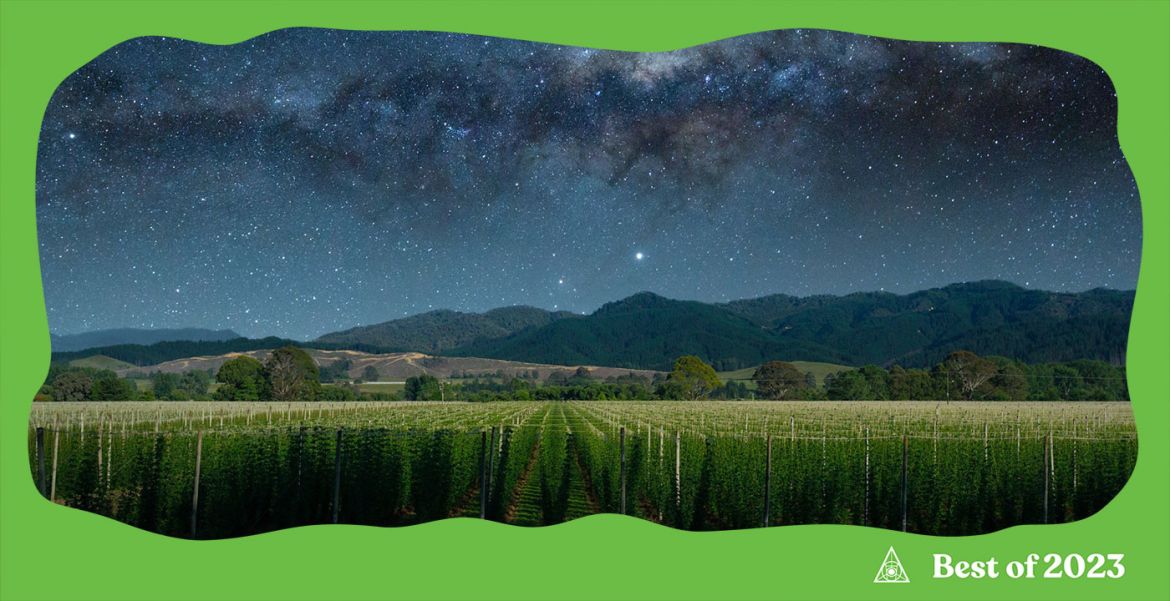
Were you even brewing in 2023 if you haven’t used Kiwi hops?
Hops from across The Ditch have long been available in Australia, but the last couple of years, and 2023 in particular, have seen them become pretty much ubiquitous. In part, this is through increasingly regular collaborations between the country’s growers and local brewers, as well as through a heightened presence at festivals and industry events.
The two newest commercial releases from NZ Hops, Nectaron and Superdelic, frequently appear as the stars in single hop releases. The latter rose from last year’s Bract Brewing Programme, which sees brewers across the globe invited to trial varieties yet to make it to full commercial release, when it was tagged NZH-102. With this year’s NZHs doing the rounds – Moon Dog World even hosted a festival based around many of this year’s beers last month – expect that pair to have company soon enough.
New Zealand’s largest hop grower, Clayton Hops, also released a number of new hop products in 2023, while Freestyle Hops have been working closely with some of Australia’s best-loved hop-forward brewers; their Hop Kief product has been proving particularly sought-after by brewers as 2023 has progressed, as has the thiol-pushing Phantasm we wrote about at the end of last year.
Of course, it’s not just our brothers and sisters across the Tasman playing with innovative hop products. HPA showcased a bunch of liquid hop products in their 2023 mixed-pack showcase Even Flow, and we’re long overdue in publishing an explainer for readers on just what FLEX, and Cryo hops, and SPECTRUM, and LUPOMAX and their ™’d ilk mean when you see them championed on labels. WZ
4. Malt Matters
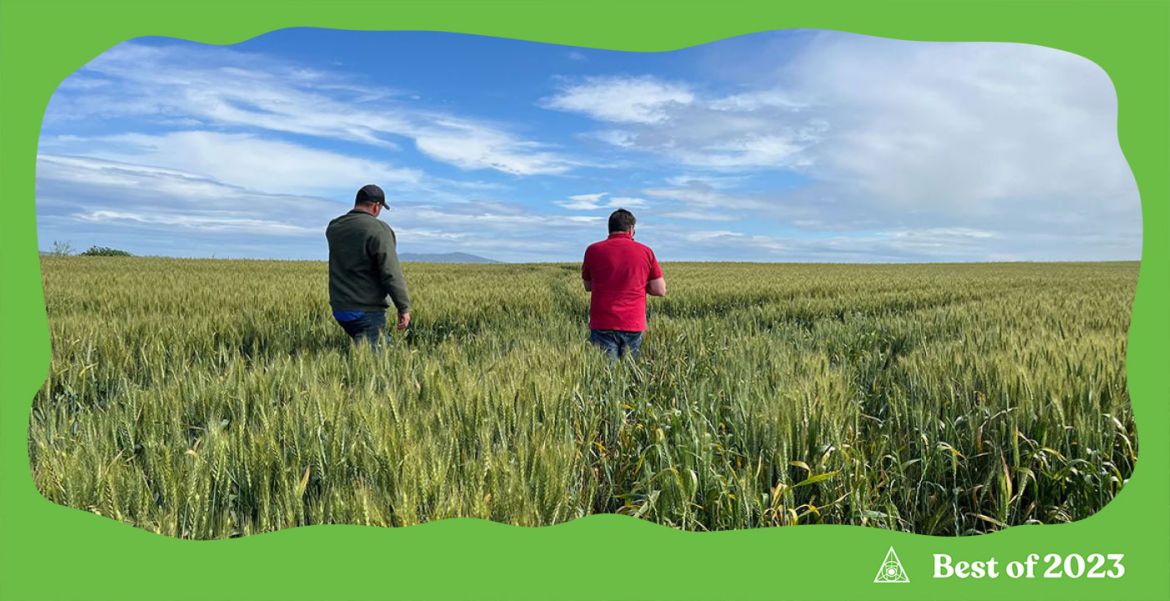
Looking more locally, it’s been a big year for Australian malt. Bintani, Joe White, Rocky Ridge, Tolga Farm, Certified Sustainable, and CBH Group came together in a project to supply grain with a keen focus on sustainability, with that approach extended into the Joe White Signature Malt range. Speaking of collaborations, a partnership between one of the region’s largest operators, Cryer Malt, and the fast-growing indie maltster Voyager resulted in Dexter Malt, gives brewers the first dextrin malt grown and malted in Australia.
While malt still doesn’t capture the attention of drinkers in the same way hops do, the diversity on offer to brewers, and the innovation to be found throughout the industry feels a lot like what’s been happening in the world of hops for years. If a brewer is keen to make an organic or low beer-mile beer, there will be Australian options to assist them. If someone is looking for a particular flavour, texture, or colour, there’s a chance they can find a malt variety – local or imported – that will do the trick for them.
Innovation only looks set to continue with AMSAT Character Malts launching right at the tail-end of the year in SA, while an Australian woman, Cristal Peck, is pioneering Infusion Malts in Belgium. Furthermore, this article about North American barley caught our eye due to its discussion of how barley breeders are using new tools and a collaborative approach to bring out varieties specifically designed for craft breweries.
We could probably argue something similar for the local yeast production industry, but that will be touched upon elsewhere in this end of year series. WZ
5. Aussies Abroad
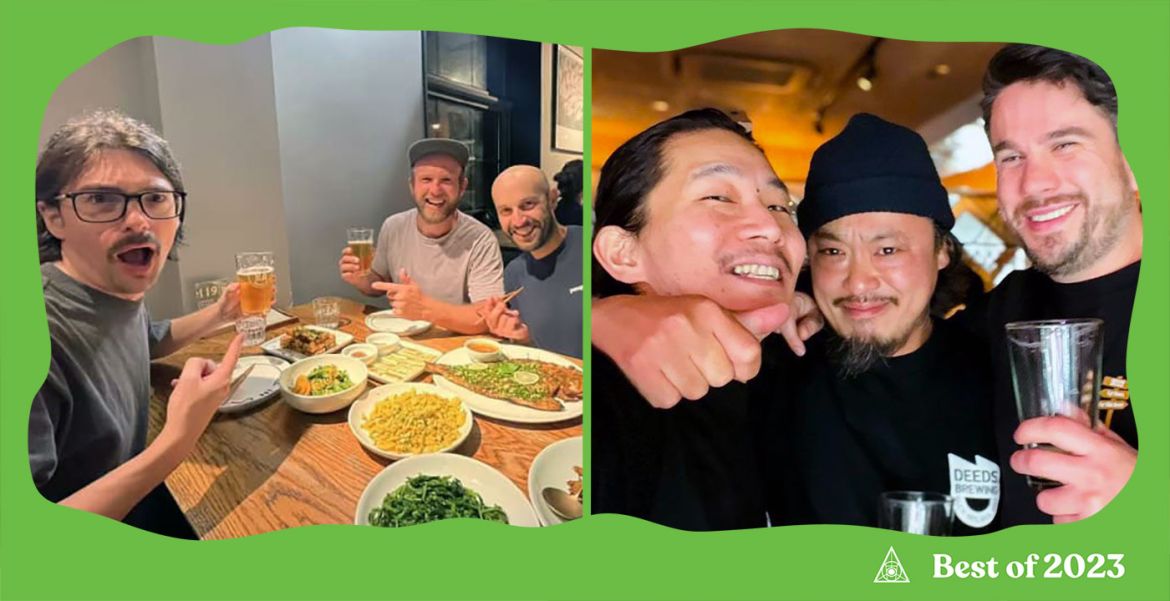
It’s not just been holidaymakers satisfying their post-lockdown urge to travel overseas and hitting the road. Australian beer is starting to make more inroads internationally too, most notably around the Asia-Pacific region.
Back in May, we wrote about the burgeoning bonds between Aussie and Japanese craft brewers, and recent discussions tell us it’s proving quite the handy outlet for brewers who’ve found favour there while they await the return of normality in their home market.
There’s long been an export market for Aussie brewers in parts of the Asia-Pacific region – some can report more than a decade of steady overseas supply – but it’s reaching into new areas and in different ways. It’s something we’ll be exploring in more detail in the new year, but with promising signs in China – where a bunch of Aussie brewers travelled last month for the 8x8 Festival in Beijing – might there be an opportunity for Australia to position itself as the preeminent craft brewing nation for the region?
International bonds continue to be forged between brewers in other ways too. Even during the height of the pandemic, brewers managed to continue to collaborate with their peers in all parts of the planet, but 2023 does seem to have seen this trend upwards again.
Bridge Road brought Firestone Walker’s Matt Brynildson over for the High Country Hop symposium and festival in March, joining forces with him to brew their annual Dark Harvest fresh hop beer, while there was a smattering of global gatherings in beer form across many of the Pint of Origin venues in Melbourne in May.
Balter’s Mouth Holiday took them on a tour of the US to brew a cracking trio of beers with Figueroa Mountain, Cloudburst and Green Cheek. Range have since brewed their own collab with the last of those, set to be released alongside collabs with their pals at One Drop and Bracket.
As the year drew to a close, Mountain Culture got it on with one of the biggest names in the States, creating Summer Pale Ale with Sierra Nevada (around about the time we learned we’d be seeing far fewer of the Chico icon’s beers Down Under) and have since released another beer with Firestone Walker. Fox Friday got in on the action with Weldwerks Brewery and the distributors at Forward Hops, and, well, you get the message.
6. Frontline Focus
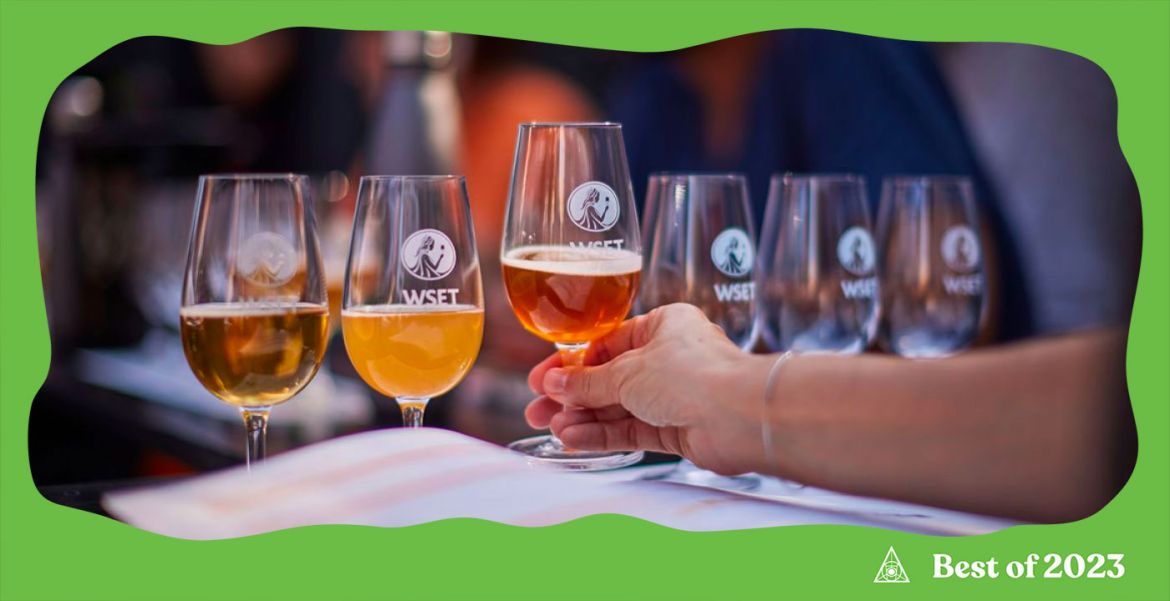
As the industry works through the ways in which it can broaden beer’s appeal and connect with new drinkers, there have been a couple of notable moves within the education space. We’ve commented over the past 12 months on a relative lack of beer education for consumers – indeed, it’s come up in numerous discussions with brewers and venue staff alike – but one way of making that more likely and of a higher quality is to focus on those who act as the interface with consumers.
The rather wordy Australian Cicerone – Certified Professionals Community have made it their mission to champion beer and promote best practice in service, while the widely-respected global organisation Wine & Spirit Education Trust (better known as WSET) moved into beer in 2023. Two Birds co-founder Jayne Lewis is working with the team here, with their Aussie courses set to commence in February 2024. WZ
7. The Bifurcation Of Lager

Yes, we had a section called Lager, Lager, Lager in the equivalent piece last year, and we’ve written about the now very real lager renaissance frequently since we spotted its earliest shoots half a decade ago. But what’s been happening in that space since is worthy of comment beyond the fact there’s ever more of them on the market.
At time of writing, the world of lager looks to be splitting into two distinct and disparate camps*: premium craftier offerings on one hand; more affordable options on the other.
In the former camp, you could lump the arms race regarding lagering times that in 2023 spread beyond its starting point in WA, as Helios went beyond that state’s brewers’ 90, 100, and 123-day pilsners with a one-off 200 day pilsner, Borealis. Frankly, if 2024 doesn’t bring with it a 365 Day Pilsner, we’re going to be a little disappointed.
That trend is, however, relatively old news when it comes to the lavish side of lager. Of more current vintage are West Coast pilsners featuring far higher hopping rates that are becoming more commonplace, perhaps encouraged by the longevity shown by the cold IPAs and the fact some brewers have turned to lager yeasts to make their West Coast IPAs tilt ever more cleanly towards their hops.
In the latter camp, you’ve got craft brewers directly targeting mainstream drinkers with beers that look and taste a whole lot like Corona, to the point at which, if there was a Dictionary of Craft Beer that anointed words of the year, surely it would be claimed by “cerveza” in 2023. We explored their rise in September and also carried out a blind tasting of such beers (which threw up an unexpected winner). Since then, Balter’s first bottle release has become pretty much an everpresent in Australian bottleshops and more breweries have joined the maize craze.
Meanwhile, rice lagers have also become an increasingly prevalent sight in Australia, both from indie and acquired craft brands, offering a combination of low cost to brew and refreshingly crisp to drink that’s well suited to straitened times. Look out for more on these beers in the coming weeks.
*OK, there's still plenty of helles and pilsner-style beers that sit in between, but it is a part of the market that's pushing outwards in both directions.
8. Ginger & Friends

A decade or so ago, there was a rush by many breweries to add a ginger beer to their lineups; if we recall correctly, plenty were getting into cider too. It proved to be a flash in the past but now, as with seltzers a few years ago, it’s hard to escape the feeling that if a brewery hasn’t already released a ginger beer, they’re either about to or are thinking about it. Even the Endeavour Group invented another brand, Big Things Brewing Co, to give Dan’s and BWS a crafty-looking homebrand ginger beer, so they must believe there’s something in it. And, if breweries aren’t ordering in ginger, they’re probably dialling in a recipe for hard lemonade.
Indeed, looking further outside beer to the wider world of booze and there’s an argument to be made for 2023 being the Year of Hard Solo, whose launch resulted in immediate condemnation from various health groups and politicians before, ultimately, falling foul of ABAC. Certainly, the number of brands in the RTD space is incredibly diverse – some of AFL’s best-known players have even joined the fray with Barry.
Whoever it is behind the brands, the marketing typically goes to great lengths to promote the low sugar content in the liquids, which brings us to…
9. “Better For You”

In recent years, non-alcoholic beers have been a growing focus for breweries big and small, and that section of the market has only become more crowded in 2023. They’re now very much part of a wider trend towards drinks that look to appeal to our healthier instincts (even if breweries are unlikely to label them as such).
Low carb beers aren’t new but their number has expanded, with the likes of BentSpoke adding one to their core range and Brick Lane now offering two: Hi-Fi Dry lager and Wild Sky Pale. Meanwhile, Better Beer’s sales have continued to grow.
Good Drinks have been pushing their latest brand, Rider Lite, hard too, putting its zero carbs, low calorie credentials front and centre, while new operation eBeer, based in the Adelaide Hills, have made similar noises around their product.
When it comes to many of these brands, the marketing is clearly targeted at younger, legal-aged drinkers of whom many breweries are terrified. Add in hop waters, designed to offer beer drinkers another booze-free option with some familiar flavours with fewer calories than non-alcs, and it’s clear we’re not in Kansas anymore (a reference sure to chime with Gen Z readers). WZ
10. Budget Busters

We started with comments on the economic and financial challenges facing the industry, so let’s end on a similar note too. Thanks to the rising costs involved in simply being alive, much of the population has been forced to work out what they can cut from their budgets.
As a result, many breweries have responded by releasing cheaper beers, often as a sub-brand. It’s not new, as such – Hawkers’ Rover brand has been selling by the truckload for a few years now, for example, but it is on the up. We blind tasted a bunch of the country’s crafty Budget Busters midway through the year; since then, Wayward and Moffat Beach have added to the selection of beers directly targeting drinkers with less to spend via their Recession Ale and Fridge Filler beers respectively.
We’ll cover more in our Best of Beer in 2023 series of features from the states and territories between now and the end of the year. Additional coverage by Will Ziebell.
And, if you missed the announcement the other day, we’re looking to pierce the gloom with a ray of light in the shape of Local Beer Day on February 24. Hopefully, you’ll be part of it wherever you are in Australia.

















